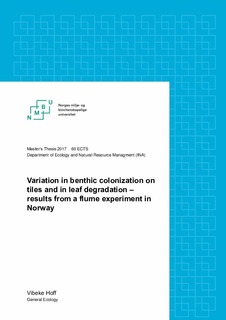| dc.contributor.advisor | Schneider, Susanne Claudia | |
| dc.contributor.author | Hoff, Vibeke | |
| dc.coverage.spatial | Norway, Ås | nb_NO |
| dc.date.accessioned | 2017-11-27T14:30:44Z | |
| dc.date.available | 2017-11-27T14:30:44Z | |
| dc.date.issued | 2017-05-15 | |
| dc.identifier.uri | http://hdl.handle.net/11250/2468156 | |
| dc.description.abstract | Clean water support economic and recreational activities as well as provide a healthy habitat for flora and fauna. Gradual pollution of water in Europa over the past decades have resulted in a water management across country boarders and increased the need for research in running waters. Freshwater research has gained important knowledge through experiments in artificial streams. Results from artificial streams may not be comparable with processes in nature, but replication and flume design improve data strength. In this thesis, eight artificial streams were constructed of stainless steel with bottom substrate of coarse gravel. Water was circulated separately for each flume. Tiles and leaves were exposed for six weeks at different longitudinal positions in each flume. It was tested if periphyton colonized the tiles differently between the flumes or between the positions in each flume, and if leaf litter degraded differently between the flumes or between the positions in each flume. Two different sampling methods were used. There were no differences between the sampling methods, which indicate that removal of random tiles and leaf litter bags did not affect the remaining tiles. There were no differences in leaf litter degradation between the flumes or between the positions in a flume. Similarly, there were no differences in colonization of algae on tiles between the flumes or positions in each flume, so neither the location of the flume nor the longitudinal position within the flume affected litter degradation or algal growth. However, algal density in Flume 1 differed from that of the other flumes. Flume 1 received groundwater while the other flumes were filled with surface water. Different water quality may be the reason why Flume 1 had different algal assemblage as well as less leaf litter degradation, than the other flumes. It was concluded that the artificial streams at Solbergstrand were suited for future experiments and they may well contribute to our further knowledge on how to keep freshwater healthy and clean. | nb_NO |
| dc.language.iso | eng | nb_NO |
| dc.publisher | Norwegian University of Life Sciences, Ås | nb_NO |
| dc.rights | Attribution-NonCommercial-NoDerivatives 4.0 Internasjonal | * |
| dc.rights.uri | http://creativecommons.org/licenses/by-nc-nd/4.0/deed.no | * |
| dc.subject | variation | nb_NO |
| dc.subject | benthic | nb_NO |
| dc.subject | stream | nb_NO |
| dc.subject | colonization | nb_NO |
| dc.title | Variation in benthic colonization on tile and in leaf degradation - results from a flume experiment in Norway | nb_NO |
| dc.type | Master thesis | nb_NO |
| dc.subject.nsi | VDP::Mathematics and natural science: 400 | nb_NO |
| dc.source.pagenumber | 35 | nb_NO |
| dc.description.localcode | M-ECOL | nb_NO |

